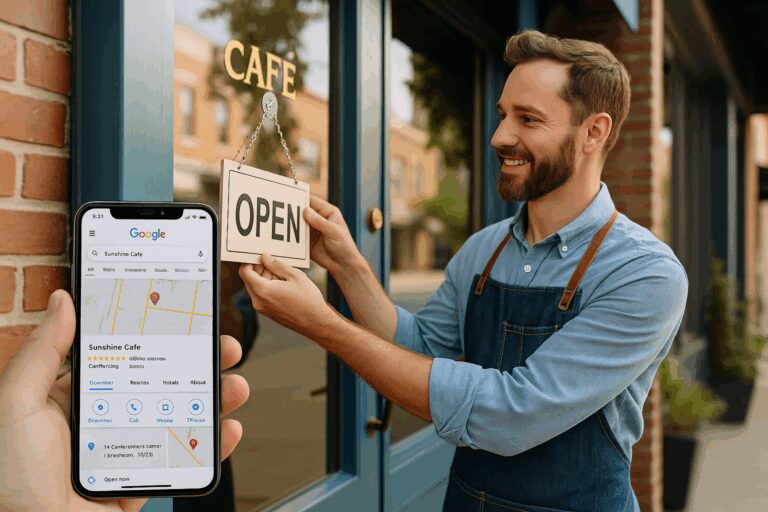Starting a business is a rush—lots of energy, ideas, and probably a fair bit of stress. The challenge is that even if you’ve nailed your service or product, no one knows you exist yet. One of the fastest, most effective ways to get found is to show up where people are already looking: Google.
That’s where your Google Business Profile (GBP) comes in. It’s free, it’s visible on Google Search and Maps, and it can put you in front of customers the very same day you set it up.
This guide will walk you through how to create, optimize, and manage your GBP so your startup can punch above its weight from day one.
1. Getting Started: Create or Claim Your Profile
The first step is to find out whether Google already has a record of your business. Do a quick search for your business name. If you see a profile with the note “Own this business?”, that means you can claim it and take control. If nothing shows up, you’ll need to create a brand-new profile from scratch.
Once you’ve claimed or created your profile, Google will ask you to verify ownership. In most cases, this now means completing a short video verification. You’ll be asked to record yourself showing proof that you’re connected to the business—such as signage, your storefront, business equipment, or even you working at the location. It only takes a few minutes, and once it’s approved, you’ll have full access to manage your listing. You can read Google’s official instructions for video verification here: Google Business Profile Help.
2. Nail the Essentials (they matter more than you think)
Before you get fancy, lock down the basics. Google pays close attention to consistency, and so do customers.
- Business name: Use your real, legal business name exactly as it appears on signage and paperwork. Avoid adding extra keywords like “best” or “#1.”
- Address and map pin: Double-check that your address is accurate and that the map pin lands exactly where it should. For storefronts in plazas or rural locations, a misplaced pin can cost you walk-in traffic.
- Phone number: Use a local number if you can. It signals to customers (and Google) that you’re truly local.
- Business hours: Make sure these are correct and update them for holidays or special hours. Out-of-date hours frustrate customers and can lead to negative reviews.
- Categories: Choose a primary category that reflects your main offering, then add a few secondary ones if appropriate. For example, a new coffee shop might select “Coffee Shop” as primary, and “Cafe” or “Breakfast Restaurant” as secondary. A lawn care startup could use “Lawn Care Service” and “Landscaper.”
3. Build Visibility with Description, Services, and Posts
Once the essentials are in place, it’s time to tell Google and potential customers exactly what you do. This is where you can stand out.
Start with a description. Write a short, friendly summary (under 750 characters) that explains who you are and what you do. For example: “We’re a family-owned coffee shop in downtown Lancaster serving locally roasted coffee, fresh pastries, and a quiet space for your morning routine.”
Next, add your services or products. Think about the specific terms your customers might type into Google. A plumber should list “emergency plumbing,” “water heater installation,” and “drain cleaning.” A boutique could list “women’s clothing,” “handmade jewelry,” and “gift cards.”
Finally, create regular posts. Share promotions, before-and-after photos, seasonal offers, or customer highlights. A landscaper might post a lawn transformation photo in spring, while a bakery could feature a new pumpkin roll in October. These posts keep your profile fresh and give customers a reason to click through.
4. Open the Doors for Customer Engagement
Reviews are the heartbeat of your profile. Ask happy customers to leave feedback early and often. Respond quickly to each review—thank people for positive ones, and handle negative ones with professionalism. A thoughtful reply to criticism often leaves a stronger impression than the glowing reviews.
Messaging allows prospects to text you directly from your listing. Many customers prefer texting over calling, and a quick response can be the difference between winning or losing their business. Make sure someone on your team is responsible for monitoring and replying.
The Q&A section is a chance to answer questions before they’re even asked. You can seed it with common questions customers usually ask, such as “Do you offer same-day service?” or “Is there parking on site?” Proactively answering these questions builds trust and reduces friction for potential customers.
5. Watch the Data and Learn
Don’t just set up your profile and forget it. The data Google provides can help you see what’s working.
Check the Performance tab to see how often people are calling you, asking for directions, or clicking through to your website. Pay attention to whether you’re showing up in the Map Pack—those top three business listings in search results. That’s the sweet spot for visibility. If your numbers aren’t trending upward, take a fresh look at your photos, categories, and posting frequency. Small tweaks often make a big difference.
6. Why It Matters for Startups
For a startup, visibility and credibility are everything. A fully optimized Google Business Profile:
- Gets you discovered in “near me” searches at the exact moment customers are looking.
- Builds trust by showing accurate information, real photos, and early customer reviews.
- Helps you generate momentum—once people start finding and choosing you, reviews and activity snowball into more visibility.
Bonus #1: Free GBP Optimization Checklist
Setting up a GBP can feel like juggling details—categories, photos, services, business hours. To help, we’ve created a Google Business Profile Optimization Checklist. It’s a simple, step-by-step PDF you can use to map out your information before (or while) you set up your profile. It’ll keep your details organized and make sure everything you enter is consistent.
📥 Click here to download the GBP Optimization Checklist
Bonus: Other Free Places to List Your Business
Google is the big one, but you’ll get more traction if your information is consistent across the web. Here are other free places to list your business:
Major national/local directories:
- Yelp
- Yellow Pages
- Facebook Business Page
- Better Business Bureau
- Chamber of Commerce
- Nextdoor
- Thumbtack
- Porch
- TripAdvisor (if relevant)
Wrapping It Up
As a startup, every dollar counts. Claiming and optimizing your Google Business Profile is one of the fastest, cheapest ways to get noticed, attract your first customers, and build credibility.
Don’t stop there—expand your presence across other directories, ask for those first reviews, and keep your listing updated. Over time, this consistent effort pays off in steady leads and stronger local visibility.
And remember, you don’t have to wing it—use the worksheet to stay organized and make the most of your time.




